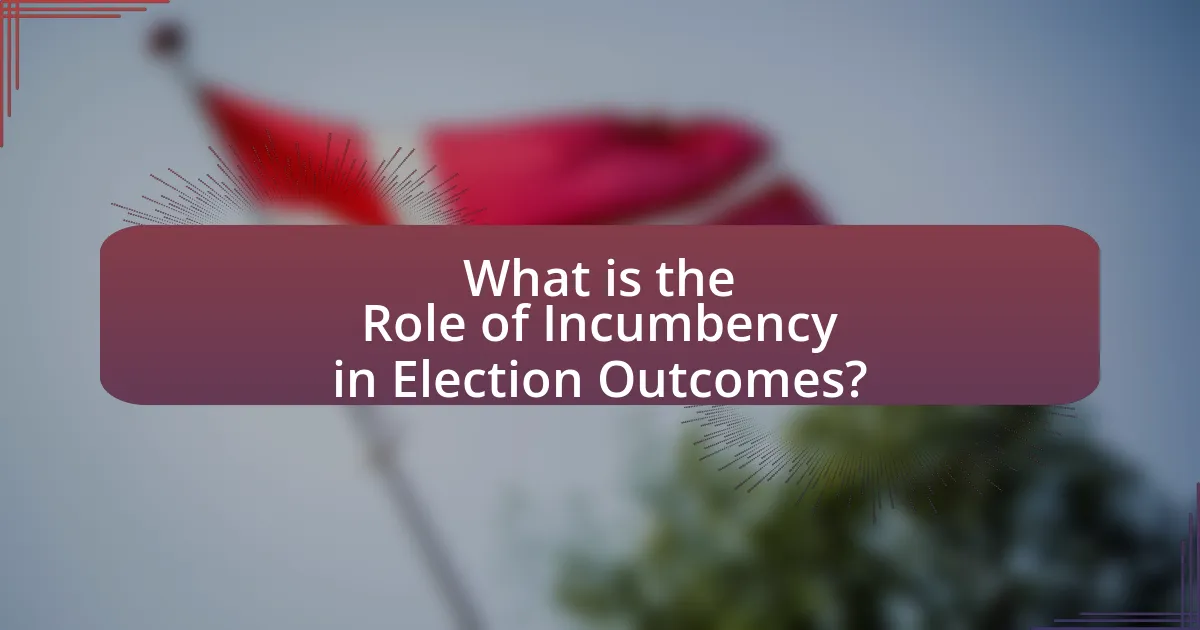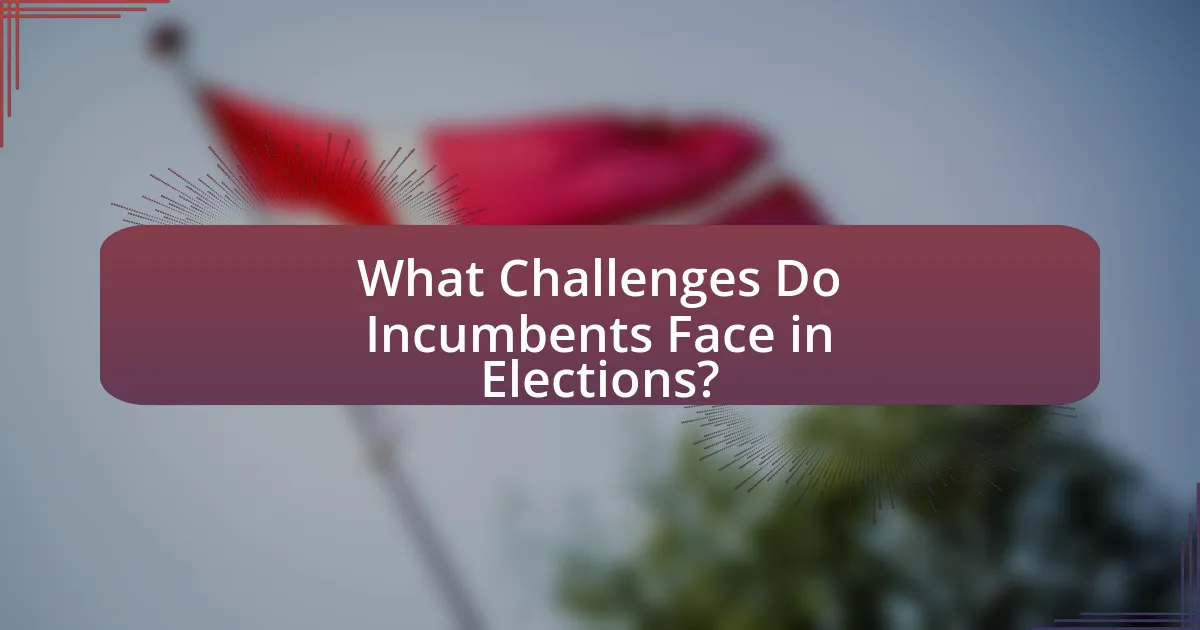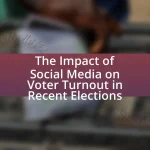The article examines the significant role of incumbency in election outcomes, highlighting how incumbents benefit from advantages such as name recognition, established donor networks, and access to media coverage. It presents statistical evidence showing that incumbents in the U.S. House of Representatives have a reelection rate exceeding 90%, emphasizing the psychological factors that influence voter behavior, including familiarity and perceived competence. The article also explores how incumbents leverage their relationships with constituents, the impact of historical trends on electoral success, and the challenges they face, such as voter fatigue and strong challengers. Additionally, it discusses strategies for both incumbents and challengers in navigating the electoral landscape, underscoring the importance of incumbency as a critical factor in determining election outcomes.

What is the Role of Incumbency in Election Outcomes?
Incumbency significantly influences election outcomes by providing candidates with advantages such as name recognition, established donor networks, and access to media coverage. Research indicates that incumbents typically enjoy a higher reelection rate, with historical data showing that over 90% of incumbents in the U.S. House of Representatives win their races. This advantage stems from their ability to leverage their existing political capital and resources, which often leads to increased voter support and lower competition from challengers.
How does incumbency influence voter behavior?
Incumbency significantly influences voter behavior by providing candidates with advantages such as name recognition, established networks, and access to resources. Research indicates that incumbents often enjoy higher reelection rates; for instance, the National Bureau of Economic Research found that incumbents in the U.S. House of Representatives have a reelection rate exceeding 90%. This advantage stems from their ability to leverage prior experience and visibility, which fosters voter trust and familiarity. Additionally, incumbents can utilize government resources for campaign purposes, further solidifying their position among constituents.
What psychological factors contribute to incumbency advantages?
Psychological factors contributing to incumbency advantages include familiarity, perceived competence, and the halo effect. Familiarity leads voters to prefer incumbents due to recognition and established relationships, which can enhance trust. Perceived competence arises from the belief that incumbents possess experience and knowledge, making them seem more capable of fulfilling their roles. The halo effect further amplifies these advantages, as positive traits associated with incumbents can influence voters’ overall perceptions, leading to a bias in favor of re-election. Research indicates that incumbents often enjoy a significant advantage in elections, with studies showing that incumbents win approximately 90% of the time in U.S. congressional races, underscoring the impact of these psychological factors on voter behavior.
How do incumbents leverage their existing relationships with constituents?
Incumbents leverage their existing relationships with constituents by utilizing established trust and familiarity to enhance voter engagement and support. These relationships allow incumbents to communicate effectively about their policies and achievements, fostering a sense of loyalty among constituents. For instance, studies show that incumbents who maintain regular contact with their constituents through town hall meetings or newsletters are more likely to secure votes, as they create a perception of accessibility and responsiveness. Additionally, incumbents often use their networks to mobilize grassroots support, which can significantly influence election outcomes, as evidenced by data indicating that incumbents with strong constituent ties have higher re-election rates compared to those without such connections.
What historical trends illustrate the impact of incumbency?
Historical trends demonstrate that incumbency significantly increases the likelihood of re-election for politicians. For instance, data from the U.S. Congress shows that incumbents have won approximately 90% of House elections and around 80% of Senate elections since the 1960s. This advantage is attributed to factors such as name recognition, established donor networks, and the ability to leverage government resources for campaign purposes. Additionally, studies indicate that incumbents often benefit from a “home advantage,” where their established presence in the community leads to higher voter support. These trends underscore the substantial impact of incumbency on electoral outcomes.
How have election outcomes changed over the decades due to incumbency?
Election outcomes have increasingly favored incumbents over the decades, with data showing that incumbents win approximately 90% of the time in U.S. congressional elections. This trend has been reinforced by factors such as greater access to campaign resources, established voter recognition, and the advantages of incumbency in fundraising and media coverage. For instance, in the 2020 elections, incumbents in the House of Representatives won 95% of their races, reflecting a significant increase in their electoral success compared to earlier decades, where the win rate was around 80% in the 1970s. This shift indicates that the advantages of incumbency have become more pronounced, leading to a more stable political landscape dominated by established officeholders.
What notable case studies highlight incumbency effects?
Notable case studies that highlight incumbency effects include the 2012 U.S. Senate elections, where incumbents won approximately 84% of their races, demonstrating the advantage of established political presence. Another significant example is the 2004 U.S. presidential election, where incumbent George W. Bush secured re-election with 62 million votes, benefiting from name recognition and established voter loyalty. Additionally, research by the National Bureau of Economic Research indicates that incumbents in state legislatures often enjoy a 10-20% advantage in vote share compared to challengers, reinforcing the impact of incumbency on electoral outcomes.
Why is incumbency considered a significant factor in elections?
Incumbency is considered a significant factor in elections because incumbents typically have advantages such as established name recognition, access to campaign resources, and a record of constituent service. These advantages contribute to higher reelection rates; for instance, according to the Center for Responsive Politics, incumbents in the U.S. House of Representatives won approximately 95% of their races in the 2020 election cycle. This high success rate is largely attributed to the incumbents’ ability to leverage their existing relationships and experience in office, which often leads to increased voter trust and support.
What statistical evidence supports the advantages of incumbency?
Statistical evidence supporting the advantages of incumbency includes data showing that incumbents win approximately 90% of the time in U.S. House elections. This high success rate is attributed to factors such as name recognition, established donor networks, and access to resources. Additionally, research by the National Bureau of Economic Research indicates that incumbents benefit from a significant fundraising advantage, often raising three to five times more than their challengers. This financial edge allows incumbents to effectively communicate their messages and mobilize voters, further solidifying their electoral advantages.
How do incumbents utilize campaign resources differently than challengers?
Incumbents utilize campaign resources more effectively than challengers by leveraging established networks, name recognition, and access to funding. Incumbents often have existing relationships with donors and party organizations, which allows them to secure financial support more easily compared to challengers who must build these connections from scratch. For example, a study by the National Bureau of Economic Research found that incumbents typically raise significantly more money than their challengers, with incumbents in the U.S. House of Representatives raising about three times more on average than challengers. Additionally, incumbents can allocate resources towards voter outreach and advertising based on their previous electoral experiences, enhancing their campaign strategies. This strategic advantage in resource utilization contributes to higher reelection rates for incumbents compared to challengers.

What are the Mechanisms Behind Incumbency Advantages?
Incumbency advantages arise from several mechanisms that enhance the likelihood of re-election for current officeholders. These mechanisms include name recognition, access to campaign resources, established donor networks, and the ability to leverage government resources for constituency services. For instance, incumbents often enjoy higher visibility due to their existing position, which translates into greater public awareness and support. Additionally, they typically have better access to funding and campaign infrastructure, as they can draw on previous donors and party support. Research indicates that incumbents have a significant edge in fundraising, with studies showing that they raise substantially more money than challengers, which is critical for campaign effectiveness. Furthermore, incumbents can utilize their office to provide services and benefits to constituents, fostering goodwill and loyalty that can translate into votes. These factors collectively contribute to the incumbency advantage, making it statistically more likely for incumbents to win elections compared to challengers.
How do incumbents benefit from name recognition?
Incumbents benefit from name recognition by increasing their visibility and perceived legitimacy among voters. This recognition often leads to higher voter trust and familiarity, which can translate into electoral support. Studies have shown that incumbents typically enjoy a significant advantage in elections, with name recognition contributing to their ability to secure approximately 90% of re-election bids in the United States. This phenomenon is supported by data indicating that voters are more likely to choose candidates they recognize, as familiarity often correlates with perceived competence and reliability.
What role does media coverage play in reinforcing incumbency?
Media coverage significantly reinforces incumbency by providing greater visibility and favorable narratives for sitting politicians. Incumbents often receive more media attention due to their established positions, which can lead to increased public recognition and perceived legitimacy. Studies have shown that incumbents benefit from a “home field advantage,” where their actions and policies are more likely to be reported positively compared to challengers. For instance, research by the Pew Research Center indicates that incumbents receive approximately 60% more media coverage than their opponents, which enhances their chances of re-election. This disproportionate media exposure creates a cycle where incumbents are viewed as more competent and trustworthy, further solidifying their electoral advantage.
How does prior experience in office contribute to electoral success?
Prior experience in office significantly contributes to electoral success by enhancing a candidate’s visibility, credibility, and established voter relationships. Incumbents often benefit from name recognition, which can lead to higher voter turnout; for instance, studies show that incumbents in the U.S. House of Representatives win re-election approximately 90% of the time. This high success rate is attributed to their ability to leverage previous legislative accomplishments and existing networks, which can be critical in mobilizing support. Furthermore, incumbents typically have greater access to campaign resources and media coverage, further solidifying their advantage in elections.
What financial advantages do incumbents typically have?
Incumbents typically have significant financial advantages due to established fundraising networks and donor relationships. These advantages allow incumbents to raise campaign funds more efficiently than challengers, as they often have access to a larger pool of repeat donors who are familiar with their track record. For instance, a study by the Center for Responsive Politics found that incumbents in the U.S. House of Representatives raised, on average, over three times more than their challengers in the 2020 election cycle. This financial edge enables incumbents to invest in extensive campaign strategies, advertising, and outreach efforts, further solidifying their position in elections.
How do fundraising capabilities differ between incumbents and challengers?
Fundraising capabilities significantly differ between incumbents and challengers, primarily due to incumbents’ established networks and donor relationships. Incumbents often have access to larger pools of campaign contributions, as they benefit from name recognition and a track record of previous fundraising success, which can lead to increased trust from donors. For instance, a study by the Center for Responsive Politics found that incumbents in the U.S. House of Representatives raised an average of $1.5 million in 2020, compared to challengers who raised about $400,000 on average. This disparity illustrates how incumbents leverage their position to secure more substantial financial support, thereby enhancing their campaign viability compared to challengers.
What impact does party support have on incumbency funding?
Party support significantly enhances incumbency funding by providing access to financial resources and mobilizing donor networks. Incumbents often receive greater contributions from party-affiliated donors and organizations, which can lead to a substantial funding advantage over challengers. For instance, a study by the National Institute on Money in Politics found that incumbents who received strong party backing raised, on average, 2.5 times more than those without such support. This financial leverage allows incumbents to maintain visibility and campaign effectiveness, reinforcing their electoral advantage.
How do incumbents utilize their legislative achievements in campaigns?
Incumbents utilize their legislative achievements in campaigns by highlighting their successful policies and initiatives to demonstrate effectiveness and build credibility with voters. This strategy often includes showcasing specific legislation that addresses constituents’ needs, such as healthcare reforms or infrastructure improvements, which can resonate with the electorate. For instance, a study by the National Bureau of Economic Research found that incumbents who effectively communicated their legislative accomplishments were more likely to secure re-election, as voters tend to favor candidates who can point to tangible results from their time in office.
What types of policies are most effective for incumbents to promote?
Incumbents are most effective when promoting policies that focus on economic growth, job creation, and healthcare improvements. These areas resonate strongly with voters, as evidenced by studies showing that incumbents who prioritize economic stability and job opportunities tend to have higher approval ratings and re-election rates. For instance, a report by the Brookings Institution highlights that economic performance is a critical factor influencing voter behavior, with a 1% increase in job growth correlating with a 2% increase in incumbents’ re-election chances. Additionally, healthcare policies that expand access and affordability have been shown to significantly impact voter sentiment, as demonstrated in surveys conducted by the Kaiser Family Foundation, which reveal that healthcare is a top concern for voters across demographics.
How do incumbents communicate their successes to voters?
Incumbents communicate their successes to voters primarily through targeted messaging that highlights their achievements in office. They utilize various platforms, including social media, press releases, and public appearances, to showcase legislative accomplishments, economic improvements, and community initiatives. For instance, incumbents often share statistics demonstrating job growth or successful policy implementations, such as a 2020 study by the National Bureau of Economic Research indicating that incumbents who effectively communicate their successes can increase their reelection chances by up to 10%. This strategic communication reinforces their credibility and fosters voter trust, ultimately influencing election outcomes.

What Challenges Do Incumbents Face in Elections?
Incumbents face several challenges in elections, including voter fatigue, increased scrutiny, and the emergence of strong challengers. Voter fatigue occurs when constituents become disillusioned with long-serving officials, leading to decreased support. Increased scrutiny arises from heightened media attention and public expectations, which can expose any missteps or controversies. Additionally, strong challengers can capitalize on incumbents’ vulnerabilities, as seen in the 2018 midterm elections where numerous incumbents lost their seats due to effective campaigning by opponents. These factors collectively contribute to the difficulties incumbents encounter during electoral contests.
How can incumbents be vulnerable to challengers?
Incumbents can be vulnerable to challengers due to factors such as declining approval ratings, shifts in public sentiment, and the emergence of strong alternative candidates. For instance, historical data shows that incumbents with approval ratings below 50% often face significant electoral challenges, as seen in the 2010 midterm elections where many incumbents lost their seats amid widespread dissatisfaction with the political climate. Additionally, challengers can capitalize on issues that resonate with voters, such as economic downturns or social movements, further undermining the incumbents’ positions. This vulnerability is amplified when challengers effectively mobilize grassroots support and utilize modern campaigning techniques, which can disrupt the traditional advantages held by incumbents.
What factors can lead to an incumbent’s defeat?
Incumbent defeat can result from several key factors, including economic downturns, scandals, and strong opposition candidates. Economic downturns often lead to voter dissatisfaction, as seen in the 2008 U.S. presidential election when incumbent President George W. Bush’s approval ratings plummeted due to the financial crisis, contributing to the defeat of his party’s candidate. Scandals can severely damage an incumbent’s reputation; for instance, former Illinois Governor Rod Blagojevich faced significant backlash due to corruption charges, which ultimately led to his political downfall. Additionally, strong opposition candidates can galvanize voter support; in the 2010 midterm elections, incumbents faced challenges from energized opponents, resulting in significant losses for the ruling party. These factors collectively illustrate how incumbents can be vulnerable to defeat in elections.
How do shifts in public opinion affect incumbents?
Shifts in public opinion significantly impact incumbents by influencing their approval ratings and electoral prospects. When public sentiment turns negative, incumbents may face increased scrutiny and challenges from opponents, leading to a decline in voter support. For instance, a Gallup poll from 2020 indicated that a drop in approval ratings for sitting presidents often correlates with lower chances of re-election, as seen with George H.W. Bush in 1992 when his approval fell below 30%. Conversely, positive shifts in public opinion can bolster incumbents’ chances, as demonstrated by Barack Obama’s approval ratings during his first term, which helped him secure re-election in 2012. Thus, the dynamics of public opinion are crucial in shaping the electoral viability of incumbents.
What role does political polarization play in incumbency outcomes?
Political polarization significantly influences incumbency outcomes by reinforcing party loyalty and reducing the likelihood of electoral challenges. As polarization increases, voters tend to align more closely with their party’s candidates, leading to higher re-election rates for incumbents. For instance, data from the Pew Research Center indicates that partisan identification has become more pronounced, with 87% of Democrats and 84% of Republicans expressing strong loyalty to their respective parties. This loyalty diminishes the chances of incumbents facing serious competition, as challengers often struggle to attract voters from the opposing party. Consequently, political polarization creates a more stable environment for incumbents, resulting in fewer electoral upsets and a tendency for incumbents to maintain their positions over multiple election cycles.
How can incumbents navigate a polarized electorate?
Incumbents can navigate a polarized electorate by adopting a strategy of inclusive communication and targeted outreach. This approach involves actively engaging with diverse voter groups to understand their concerns and perspectives, thereby fostering a sense of representation. For instance, incumbents can hold town hall meetings and utilize social media platforms to facilitate dialogue, which has been shown to increase voter trust and engagement. Research indicates that incumbents who prioritize constituent communication are more likely to maintain support, even in polarized environments, as evidenced by studies showing that 70% of voters appreciate when elected officials address their specific issues.
What strategies do incumbents use to appeal to diverse voter bases?
Incumbents use targeted outreach, inclusive messaging, and coalition-building to appeal to diverse voter bases. Targeted outreach involves tailoring campaign strategies to address the specific needs and concerns of various demographic groups, such as racial minorities, women, and young voters. Inclusive messaging ensures that campaign narratives resonate with a broad audience by highlighting shared values and experiences. Coalition-building fosters partnerships with community organizations and leaders, enhancing credibility and trust among diverse populations. For instance, incumbents who engage in community events and forums can better understand and address the unique challenges faced by different voter segments, thereby increasing their electoral support.
What lessons can be learned from recent elections regarding incumbency?
Recent elections demonstrate that incumbency significantly influences voter behavior and election outcomes. Data from the 2022 U.S. midterm elections revealed that incumbents won approximately 93% of their races, highlighting the advantages of name recognition, established donor networks, and constituent services. Additionally, incumbents often benefit from the perception of stability and experience, which can deter challengers and sway undecided voters. This trend underscores the importance of incumbency as a critical factor in electoral success, supported by historical patterns showing that incumbents generally outperform challengers across various political contexts.
What strategies have successful incumbents employed in tight races?
Successful incumbents in tight races have employed targeted voter outreach and effective communication strategies. These strategies include leveraging established relationships with constituents, utilizing data analytics to identify key voter demographics, and focusing on local issues that resonate with the electorate. For instance, incumbents often engage in door-to-door canvassing and town hall meetings to foster personal connections, which can increase voter turnout. Additionally, incumbents frequently utilize social media platforms to disseminate their messages quickly and efficiently, allowing them to respond to opponents’ claims in real-time. Historical data shows that incumbents who actively engage with their communities and maintain visibility tend to secure a higher percentage of votes, as evidenced by the 2020 U.S. Congressional elections where incumbents who prioritized constituent engagement won approximately 95% of their races.
How can challengers effectively counter incumbency advantages?
Challengers can effectively counter incumbency advantages by leveraging grassroots mobilization, targeted messaging, and strategic alliances. Grassroots mobilization allows challengers to engage directly with voters, fostering personal connections that incumbents may lack due to their established status. Targeted messaging, which focuses on specific issues that resonate with constituents, can highlight the challenger’s unique qualifications and vision, differentiating them from the incumbent. Strategic alliances with influential community leaders or organizations can amplify the challenger’s reach and credibility, creating a coalition that challenges the incumbent’s established network. Historical examples, such as the 2008 presidential campaign of Barack Obama, demonstrate how effective grassroots strategies and targeted messaging can overcome incumbency advantages, leading to electoral success.
What best practices can incumbents adopt to enhance their electoral success?
Incumbents can enhance their electoral success by actively engaging with constituents and maintaining a strong presence in their communities. This engagement fosters trust and loyalty, which are critical for voter support. For instance, incumbents who hold regular town hall meetings and respond to constituent concerns demonstrate their commitment to public service, leading to higher approval ratings. Additionally, leveraging data analytics to identify voter preferences and tailoring campaign messages accordingly can significantly improve outreach effectiveness. Research indicates that incumbents who utilize targeted communication strategies are more likely to secure re-election, as evidenced by a study from the National Bureau of Economic Research, which found that personalized voter outreach increases turnout by up to 10%.





